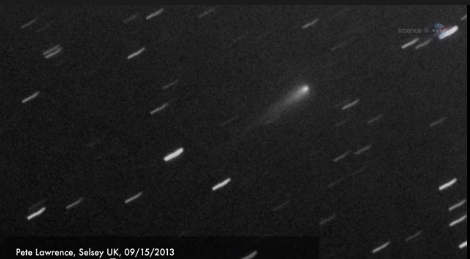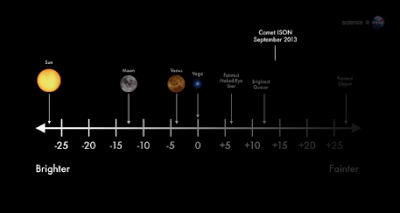

| Visitors Now: | |
| Total Visits: | |
| Total Stories: |

| Story Views | |
| Now: | |
| Last Hour: | |
| Last 24 Hours: | |
| Total: | |
Amateur Astronomers See Comet ISON Approaching The Sun, NASA Update, Videos
Comet ISON (C/2012 S1) may become a dazzling sight as it traverses the inner solar system in late 2013. During the weeks before its Nov. 28 close approach to the sun, the comet will be observable with small telescopes, and binoculars. Observatories around the world and in space will track the comet during its scorching trek around the sun. If ISON survives its searing solar passage, which seems likely but is not certain, the comet may be visible to the unaided eye in the pre-dawn sky during December.
Already, the brightening comet has become a good target for backyard telescopes in the pre-dawn sky.
On Oct. 1, ISON passes within about 6.5 million miles (10.5 million km) of Mars. As it goes by, it may be visible to some of NASA’s Mars rovers and satellites, including the Mars Reconnaissance Orbiter and Curiosity.
Like all comets, ISON is a clump of frozen gases mixed with dust. Often described as “dirty snowballs,” comets emit gas and dust whenever they venture near enough to the sun that the icy material transforms from a solid to gas, a process called sublimation. Jets powered by sublimating ice also release dust, which reflects sunlight and brightens the comet.
Sungrazing comets often shed large fragments or even completely disrupt following close encounters with the sun, but for ISON neither fate is a forgone conclusion. Whatever happens, scientists will be able to learn more about comets by how it interacts with the sun’s tenuous atmosphere, the corona.
Following ISON’s solar swingby, the comet will depart the sun and move toward Earth, appearing in morning twilight through December. The comet will swing past Earth on Dec. 26, approaching within 39.9 million miles (64.2 million km) or about 167 times farther than the moon.






I am going to make a bet that some people report it as a UFO
ISON is a UFO!!!!!!!!
Well put Alton Parish, way to go.
Um, what does ‘completely disrupt’ mean? Just kidding: still, it’s kind of like explaining falling temperatures as not warming as fast as expected.
That’s the most likely scenario, after all, given everything we know about sun grazing comets; they mostly get completely devoured by our star.
We cannot expect much different about C1 2012 but i’m hoping for a good post perihelion show. Only 60 more sleeps.